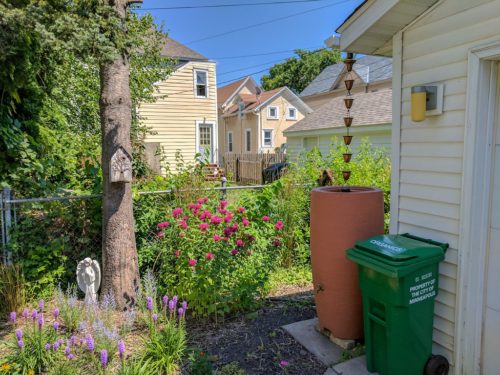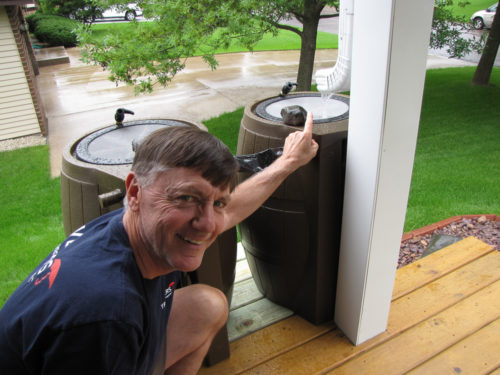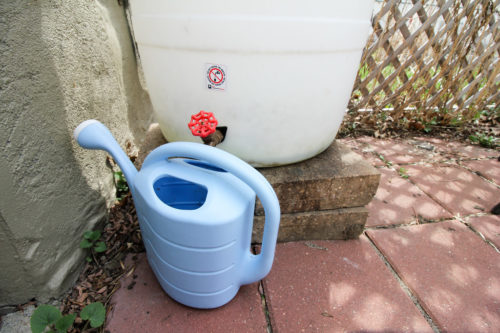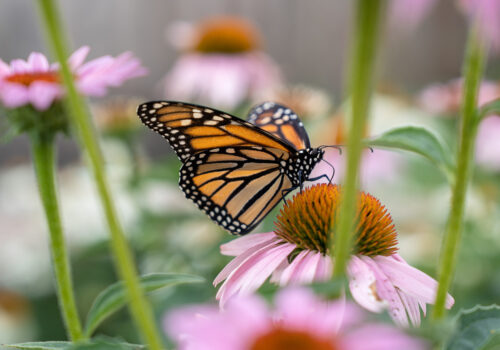Using Rainbarrels for Watering Your Yard and Garden (with Video)
Water is a part of us and our homes. Knowing the ways we interact with water helps us understand how to improve its quality and the health of our environment.
Rainbarrels are a great tool for keeping your lawns, gardens, plants, shrubs and trees healthy, especially during times of drought. By capturing the water that falls on your roof, you can utilize your cache of water for later uses. They also help by reducing the amount of stormwater that runs off into the stormdrain system, which carries pollutants into our waters.
We’ve put together a quick guide (and how-to video) on tips and considerations when installing and using a rainbarrel.
Diverting Water into the Rainbarrel

The first thing to identify is how you’ll direct rainwater into your barrel. Some methods can be achieved with a simple hacksaw or other cutting tool, while others require power tools and some careful planning.
As rain falls on your roof, it adheres to the physical surface it’s touching — starting with the roof, then likely into the gutters, and into the downspout and toward the ground. If you have gutters and downspouts, you can choose to either:
- Cut your downspout so it pours directly into your barrel (about 6 inches above the top of the barrel); or
- Install a diversion piece that redirects water to the barrel while keeping your downspout in place. (There are several types of diverters on the market. They can often be found at local hardware stores).
No-Gutter Options
If you don’t have gutters, you can still direct water into your barrel. One method is to place your barrel along the roof/drip line, though this is very inefficient. This method works best when you have two sections of a roof that converge, funneling runoff downward into a single stream. Another option is to use a rain chain, strings or chains that hangs from your roof line and into your barrel — something that lets water adhere to its surface as gravity pulls it downward.
Rainbarrel Location and Types

Another key thing to consider is where you will place your rainbarrel. You will most likely want to place it near or directly underneath a downspout; however, you should also consider proximity to the plants you’ll be watering.
The type of barrel you choose is really up to you. There are ways to reuse old containers for do-it-yourself rainbarrels; otherwise, manufactured rainbarrels come in many designs and fit many aesthetics.
When reusing an old container as a rainbarrel, options include old recycling bins or trash cans, old plastic, metal and wooden barrels, and anything that can hold water effectively. If you prefer the polished look of a manufactured rainbarrel, countless options are available for purchase online or at your local home and garden center.
Using Your Captured Rainwater
Your rainbarrel can be used for many different things, and some uses are better suited to different methods for getting the water out. If you plan on using the water on very particular plants, scooping it out with a watering can or bucket can work well. If you plan on using it mostly for one area or for the lawn, having a hose or soaker-hose attached works best.

Attaching a hose can be done in a few ways. If you do not have a manufactured rainbarrel with a pre-made connection, you can install one yourself. The best option is to install a hose or spigot connection around 4-6 inches above the base of the barrel. Installing a spigot or hose will require some additional tools like a drill with hole-saw bit, a threaded pipe connection to attach a spigot or hose, and a rubber gasket or something else to seal the threaded component with the barrel.
As for how you use the water, that is up to you! Your lawn may need water during times of drought, when the turfgrass is not getting the roughly 1 inch of water it needs per week. Watering for trees and shrubs is another option, as they tend to be under-watered in general. Other plants in your yard or garden work too, though we caution against using the water on leafy-greens you plan to eat, since they tend readily take in pollutants.
Lifting for Water Pressure
If you want a barrel that is attached to a hose or spigot, you can lift your barrel up to let gravity create pressure. Approximately 2 feet of height equals 1 pound of water pressure, and getting even 4-6 inches of lift of the barrel can help. Making sure that the barrel is on a solid base is very important, as a full rainbarrel can weigh hundreds of pounds. Bricks, cinder blocks, or 4’×4’s work well.
Overflow
One very important thing to consider is where the overflow water goes when your barrel fills up. One great option is to have another hose attached near the top of your barrel on the side. Similar to attaching a hose for using water, this will require a few extra tools. Installing a hose around 3-4 inches from the top of the barrel and diverting the hose towards plants or yard will do the trick.
Winter Maintenance
When fall comes and frosts occur at night, it’s crucial to disconnect your rainbarrel. If you have a full rainbarrel when the temperature gets below freezing for a long time, your barrel may crack when the water freezes. It’s also a good idea to reconnect any parts of your downspout that you may have cut off to make sure the late season waters flow away from the base of your house.
We created a video (below) demonstrating the basics of rainbarrels and installation.



